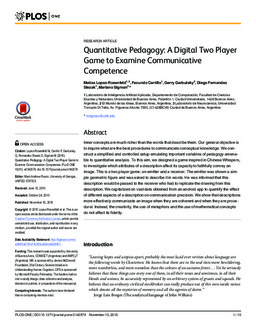Mostrar el registro sencillo del ítem
Quantitative pedagogy : a digital two player game to examine communicative competence
| dc.rights.license | http://creativecommons.org/licenses/by/4.0/ | es_AR |
| dc.contributor.author | López-Rosenfeld, Matías | es_AR |
| dc.contributor.author | Carrillo, Facundo | es_AR |
| dc.contributor.author | Garbulsky, Gerry | es_AR |
| dc.contributor.author | Fernandez Slezak, Diego | es_AR |
| dc.contributor.author | Sigman, Mariano | es_AR |
| dc.date.accessioned | 2018-08-05T18:59:03Z | |
| dc.date.available | 2018-08-05T18:59:03Z | |
| dc.date.issued | 2015-11-10 | |
| dc.identifier | doi: 10.1371/journal.pone.0142579 | es_AR |
| dc.identifier.uri | https://doi.org/10.1371/journal.pone.0142579 | es_AR |
| dc.identifier.uri | https://repositorio.utdt.edu/handle/20.500.13098/11072 | |
| dc.description.abstract | nner concepts are much richer than the words that describe them. Our general objective is to inquire what are the best procedures to communicate conceptual knowledge. We con- struct a simplified and controlled setup emulating important variables of pedagogy amena- ble to quantitative analysis. To this aim, we designed a game inspired in Chinese Whispers, to investigate which attributes of a description affect its capacity to faithfully convey an image. This is a two player game: an emitter and a receiver. The emitter was shown a sim- ple geometric figure and was asked to describe it in words. He was informed that this description would be passed to the receiver who had to replicate the drawing from this description. We capitalized on vast data obtained from an android app to quantify the effect of different aspects of a description on communication precision. We show that descriptions more effectively communicate an image when they are coherent and when they are proce- dural. Instead, the creativity, the use of metaphors and the use of mathematical concepts do not affect its fidelity. | es_AR |
| dc.format.extent | 10 p. | es_AR |
| dc.format.medium | application/pdf | es_AR |
| dc.language | eng | es_AR |
| dc.relation.ispartof | PLoS ONE 10(11), (2015). ISSN: 1932-6203 | es_AR |
| dc.rights | info:eu-repo/semantics/openAccess | es_AR |
| dc.subject | Pedagogía experimental | es_AR |
| dc.subject | Habla | es_AR |
| dc.subject | Psicología de la comunicación | es_AR |
| dc.subject | Creatividad | es_AR |
| dc.subject | Lenguaje hablado | es_AR |
| dc.title | Quantitative pedagogy : a digital two player game to examine communicative competence | es_AR |
| dc.type | info:eu-repo/semantics/article | es_AR |
| dc.subject.keyword | Creativity | es_AR |
| dc.subject.keyword | Games | es_AR |
| dc.subject.keyword | Speech | es_AR |
| dc.subject.keyword | Social communication | es_AR |
| dc.subject.keyword | Language | es_AR |
| dc.subject.keyword | Pedagogy | es_AR |
| dc.subject.keyword | Emotions | es_AR |
| dc.subject.keyword | Verbal communication | es_AR |
| dc.type.version | info:eu-repo/semantics/publishedVersion | es_AR |
| dc.description.filiation | Fil: López-Rosenfeld, Matías. Laboratorio de Inteligencia Artificial Aplicada, Departamento de Computación, Facultad de Ciencias Exactas y Naturales, Universidad de Buenos Aires, Pabellón 1, Ciudad Universitaria, 1428 Buenos Aires, Argentina. Universidad Torcuato Di Tella, Escuela de Negocios, Laboratorio de Neurociencia, Buenos Aires, Argentina | es_AR |
| dc.description.filiation | Fil: Carrillo, Facundo. Laboratorio de Inteligencia Artificial Aplicada, Departamento de Computación, Facultad de Ciencias Exactas y Naturales, Universidad de Buenos Aires, Pabellón 1, Ciudad Universitaria, 1428 Buenos Aires, Argentina | es_AR |
| dc.description.filiation | Fil: Garbulsky, Gerry. El Mundo de las Ideas, Buenos Aires, Argentina | es_AR |
| dc.description.filiation | Fil: Fernandez Slezak. Laboratorio de Inteligencia Artificial Aplicada, Departamento de Computación, Facultad de Ciencias Exactas y Naturales, Universidad de Buenos Aires, Pabellón 1, Ciudad Universitaria, 1428 Buenos Aires, Argentina. | es_AR |
| dc.description.filiation | Fil: Sigman, Mariano. Universidad Torcuato Di Tella, Escuela de Negocios, Laboratorio de Neurociencia, Buenos Aires, Argentina | es_AR |

